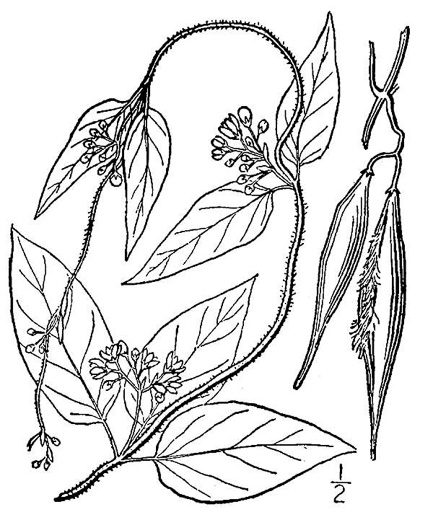Spermatophytes (seed plants): Angiosperms (flowering plants): Eudicots: Core Eudicots: Asterids: Lamiids: Gentianales
WEAKLEY'S FLORA OF THE SOUTHEASTERN US (4/24/22):
Vincetoxicum nigrum
FAMILY
Apocynaceae
Go to FSUS key
Dig deeper at SERNEC, a consortium of southeastern herbaria.
Check out EDDMapS.org to see where this has been reported.
Read more about Black Swallow-wort at Vascular Plants of North Carolina.
SYNONYMOUS WITH
PLANTS NATIONAL DATABASE:
Cynanchum louiseae
FAMILY
Asclepiadaceae
SYNONYMOUS WITH Floristic Synthesis of North America. BONAP (Kartesz, 2021)
Cynanchum louiseae
SYNONYMOUS WITH Manual of Vascular Plants of NE US & Adjacent Canada (Gleason & Cronquist,1991)
Vincetoxicum nigrum
SYNONYMOUS WITH Britton & Brown Illus Flora of Northeast US & adjacent Canada (Gleason, 1952)
Cynanchum nigrum
COMMON NAME:
Black Swallow-wort, Dog-Strangling Vine
To see larger pictures, click or hover over the thumbnails.
WEAKLEY'S FLORA OF THE SOUTHEASTERN US (4/24/22):
Vincetoxicum nigrum
FAMILY
Apocynaceae
SYNONYMOUS WITH
PLANTS NATIONAL DATABASE:
Cynanchum louiseae
FAMILY
Asclepiadaceae
SYNONYMOUS WITH
Floristic Synthesis of North America. BONAP (Kartesz, 2021)
Cynanchum louiseae
SYNONYMOUS WITH
Manual of Vascular Plants of NE US & Adjacent Canada (Gleason & Cronquist,1991)
Vincetoxicum nigrum
SYNONYMOUS WITH
Britton & Brown Illus Flora of Northeast US & adjacent Canada (Gleason, 1952)
Cynanchum nigrum
If a search such as "Carex leptalea var. leptalea" doesn't deliver the results you want, try "Carex leptalea".
Or, to minimize chances of a misspelling, try just "Carex le".
Less is more: If "pencil flower" doesn't deliver the results you want, try "pencil".


